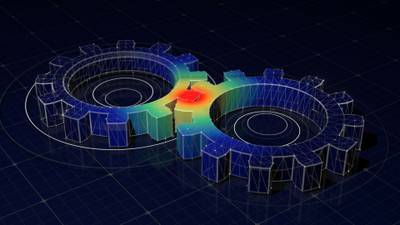Study robot arm kinematics and dynamics online.
Robot arms are the most popular type of industrial robot.
In this Masters-level online course, you’ll develop your understanding of robotic arms and their use across a range of industries.
With expert guidance, you’ll learn about:
- kinematics, dynamics, and control
- the key parameters for selecting robots for specific applications
- essential concepts in the modelling and control of robot arms
- fundamentals of robotic arms that are important for all modern robotics.
By the end of the course, you’ll understand how robot arms move, how they work, and how to control them.
Who can join this industrial robot arms course?
This course is designed for graduates from relevant academic backgrounds, primarily engineering.
To succeed in this course, you need to have a very good understanding of matrices, vectors, kinematics, and dynamics.

Build credits towards a Masters degree
This short course is part of online:
You can use the credits you earn with this short course towards either of these MSc qualifications.
What you’ll study
In this course, we’ll provide you with a complete introduction to the fundamentals of robotic arms, including kinematics, dynamics, and control.
You’ll study topics including:
- Introduction to industrial robot arms
- Mathematical modelling and symbolic representation of robots
- Types of manipulators: articulated, spherical, Cartesian and parallel
- Rigid motions and homogeneous transformations
- Forward kinematics
- Inverse kinematics
- Velocity kinematics
- Dynamics, including the Euler-Lagrange equations and Newton-Euler formulation
- Force control.
By the end of this course, you’ll be able to...
-
Understand the structure of robot arms and the spatial transformations needed to describe them.
-
Derive forward and inverse kinematics equations of most common robot-arm systems.
-
Derive the geometric Jacobian, analytical Jacobian, and singularities of a robot arm.
-
Evaluate the dynamics of a robot manipulator using the equations of motion and Newton-Euler formulation.
-
Use coordinate frames and kinematics models to describe position and orientation of mobile robots in the 3D space.

We’re part of The Turing University Network
You’ll benefit from our membership of this innovative network that was founded by The Alan Turing Institute.
The network encourages knowledge sharing and collaboration between UK universities with an interest in data science and AI, and the Turing Institute itself.
Choose the University of Aberdeen for online industrial robotics training

Earn as you learn
We fit around full-time work, so you can build qualifications while you keep earning a salary.

You’re in expert hands
We’ve been training world-class engineers for over 100 years and delivering online learning for decades.

20% alumni discount
University of Aberdeen alumni get 20% off fees for this online course.
How you’ll study
Online learning
This distance-learning course in robot arms is delivered flexibly, 100% online.
You can learn with us anywhere in the world, no student visa required, and manage your hours to suit you.
Your teaching
This course is taught at Masters level.
Teaching is delivered through MyAberdeen, our online Virtual Learning Environment (VLE). It holds all the materials, tools and support you’ll need in your studies. Take a look around MyAberdeen.
You can access your learning materials on computer, smartphone and laptop, 24 hours a day. You’ll find a range of resources available, including:
- pre-recorded video lectures
- tutorials and practice questions
- reading materials
- the online resources of our award-winning Sir Duncan Rice Library.
Your tutors
This course is delivered by our School of Engineering.
You’ll learn from academics who are active researchers in the robotics area, with expertise in mechatronic systems, instrumentation and control, and mobile robotics.
This course is assessed online.
You’ll be assessed throughout your course via:
- an individual design project (worth 30% of your final course grade), and
- an online exam (70%).
The course totals approximately 150 hours of study and assessment time. That’s around 10 – 15 hours per week.
This is an indicative guide to the time required for a typical student at this level to achieve the learning outcomes. This includes time for independent study, as well as teaching and assessments.
You can largely set your own study hours each week to cover the materials. MyAberdeen is available 24/7, so you can log in and study when it suits you.
Activities with deadlines
There will be some activities scheduled at fixed times, such as assessments with deadlines, or meetings with your tutor. But otherwise, you can access and work through the course at your convenience.
Our first-class support structure will ensure that you aren’t alone in your studies. You’ll have contact with your tutors via MyAberdeen and email. You can use social media and discussion boards to chat with your fellow students too.
We provide a wide range of services to support you in your studies and beyond:
- Careers and Employability Service
- Disability support
- IT support
- Library support
- Student Support Service – help with finances, wellbeing and non-academic issues
- Student Learning Service – study support, with advice sessions available
- Aberdeen University Students’ Association (AUSA) – run by students for students
- Toolkit – clever apps and free training that can make your study life easier
Wherever you are in the world, you’ll feel part of our very special Aberdeen learning community.
Your course coordinator

Dr Andres San Millan Rodriguez
Andres is a Lecturer in Robotics in our School of Engineering.
His expertise and research interests include origami-inspired soft robots, mobile robots, applied control, and mechatronics.
View Andres’ profileWhere this will take you
Towards a Masters
You’ll earn 15 credits at Masters level (SCQF Level 11) with this course. You can use these credits towards:

Masters in Industrial Robotics
Build your skills in engineering and AI, and learn to develop robotics technologies for diverse industry sectors.
View MSc Industrial Robotics
MSc Robotics and Artificial Intelligence
Develop the engineering and computer science skills you need to design, operate, control, and integrate robots and AI in industrial processes.
View MSc Robotics and AICareers
This course will prepare you for roles in robotics and automation.
Robotics plays a crucial role in the new wave of industrial advancement known as Industry 4.0, and the use of robots is growing rapidly around the world.
You’ll complete this course with the tools you need to use and control robot arms, which are the most common type of industrial robot, in use across a range of sectors.
Continuing Professional Development (CPD)
Your employer or professional institute may recognise this course for CPD hours. Talk to your employer or institute to find out more.

Free career support
Access our free careers service while you study.
- 1:1 appointments
- CV checks
- Interview prep
- Job opportunities
Entry requirements
Entry requirements
We welcome students from all over the world.
This course has no formal entry requirements. You do not need to provide proof of your qualifications.
But you do need to check the entry guidance above to understand the level of teaching delivered, to decide if this course is right for you.
If you do not have qualifications from the UK, check the equivalent teaching level for your country.
Visa requirements
You do not need a student visa to study online with us.
English language requirements
Teaching is delivered in English.
You do not have to provide proof of your English language skills to join this course. But we want to make sure that you can use English well enough to study successfully.
Recommended level of English
For this course, we recommend the following level of English language proficiency.
These are our Postgraduate Standard requirements, and these are minimum scores.
IELTS Academic, IELTS UKVI Academic, or IELTS Online (not IELTS Indicator or IELTS General Training)
- 6.5 overall
- 5.5 for listening, reading and speaking
- 6.0 for writing
TOEFL iBT or TOEFL iBT Home Edition
- 90 overall
- 17 for listening
- 18 for reading
- 20 for speaking
- 21 for writing
- TOEFL DI code is 0818
Cambridge English: B2 First, C1 Advanced, or C2 Proficiency
- 176 overall
- 162 for listening, reading and speaking
- 169 for writing
LanguageCert Academic / LanguageCert Academic SELT
- 70 overall
- 60 for listening, reading and speaking
- 65 for writing
Oxford ELLT Digital – English Language Level Test Online
- 7.0 overall
- 5.0 for listening, reading and speaking
- 6.0 for writing
PTE Academic (online test not accepted)
- 62 overall
- 59 for listening, reading, speaking and writing
Skills for English: SELT
- B2 pass with merit
Duolingo – tests taken from 1 July 2024 onward
- 120 overall
- 95 for listening, reading and speaking
- 105 for writing
University of Aberdeen English Pre-sessional Programme (PSE)
- Pass
- Valid for one year. Refresher can be offered if out of date
Pre-sessional academic English preparation programmes undertaken at other UK universities
- Pass at an equivalent of 6.5 (C1)
- B2 in all four skills
- Certification must be within one year prior to the start of your course
For full information about language requirements, see our English Language Requirements page.
You will need access to:
A computer (PC, laptop or Mac) with an up-to-date operating system
Most teaching materials are smartphone- and tablet-friendly. But we recommend a proper laptop or desktop for completing assignments comfortably.
Reliable internet access
We recommend:
- a wired connection
- a minimum download speed of 2 Mbps so you can take part fully in live sessions.
Speakers or headphones
- We recommend a headset with built-in microphone and earphones if you’re likely to study in an environment with background noise.
- A webcam is optional, but you may like to use one for some interactive sessions.
Software
We’ll give you access to Office365 applications. This means you can use online versions of Microsoft Word, Excel, PowerPoint and OneDrive and install these programs on up to five personal devices.
If your course requires specialist software, we’ll provide you with access to this and a licence that lasts throughout your studies.
See our detailed IT requirements for more information.
When you study with us, you can expect a first-class support structure so that you’re never alone in your studies.
But learning online does mean you have to motivate yourself and manage your own time.
Your most important commitment will be time – the time to work through, reflect on and understand your teaching materials.
Before you start a course that involves a high degree of independent study, we recommend looking at the time you will be able to devote to your studies each week:
- Be realistic
- Create a weekly schedule as a guide
If you have any questions about studying online, get in touch with our friendly team. We’re here to help.
Fee payment
Your course fee needs to be paid in full before you start your course.
We accept payment via Visa Debit, Visa Credit and Mastercard.
Ways to save
You may be able to get help funding this course via:
- discounts – if any discounts are available for this course, they’ll appear in the section below
- employer sponsorship – we accept full and partial fee payments from sponsors.
Find out more about funding options.
Student card
All our students are entitled to a University of Aberdeen student card. This gives you access to a range of student discounts around the city and online.
Learning resources
Access to all the books and resources you need are included in your tuition fee. They’ll be made available to you online and you do not have to buy your own copies.
Printing
You may wish to set aside a small budget for printing, depending on how you like to work.
This course has no formal entry requirements. You decide if it’s suitable for you.
The course is delivered at Masters level. To join this course, you should have at least:
- a 2:2 UK honours degree (or equivalent) in a relevant topic (eg, Engineering), and
- a very good understanding of matrices and vectors, and
- a very good understanding of kinematics and dynamics.






















































